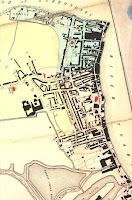Fashion like a good way to mark the beginning of the Regency. The first article talks about fashion in general, then we have some descriptions of specific plates.
General Observations on Fashion and Dress, March 1811 from the February 1811 La Belle Assemblee

The mourning for the late Princess Amelia expired on the 11th of last month, but though not general, the Court continued it in a slight degree for the deceased Queen of France. Sables are at length, however, entirely laid aside, and notwithstanding the season of Lent is not usually distinguished by much of variety, gloom seems to have subsided and gaiety and fashion fast entering on spring.
For the promenade, scarlet mantles have been so general during the mourning, that for mere variety they must now be laid aside, we think they are more frequently succeeded by the short pelisse of purple velvet, trimmed with broad black lace, or small cottage mantlet, lined with white sarsnet, ornamented with white chenille or gold. Purple sarsnet pelisses, or black velvet, lined with colours, are equally approved.
Cottage bonnets, cloth turbans, or small velvet caps, and one long dropping ostrich feather, or two small ones, are more prevailing; under the cottage bonnets, which are formed to set off from the face, small lace caps, rosettes of lace or ribband, or small flowers are much worn, with a deep blue French veil thrown over. Purple, black, or scarlet boots, are universal for walking.
For morning dress, short pelisses of cambric corded muslin, over a slip of the same, trimmed with edging, or made in poplin, bombazeen, or lustres, with ruffs and cuffs of fine clear muslin, with bands of the same, and clasps of lope de perle.
Dinner dresses are most worn in lustres, sarsnets, Opera nets, or cloth, made up to the throat with lace cuffs, collars, and small French aprons of lace or fine embroidered muslin; and lace or quilted satin tippets, trimmed with swansdown, or white chenille.
The full dress, black or white lace over coloured or white satin slips, ornamented with gold, still continue the most admired, with pearl necklaces, combs, and other ornaments blended with emeralds.—Small tippets in antique lace or satin trimmed with swansdown, are considered indispensable, and small aprons of rich antique embroidered muslin with full pockets drawn and ornamented with white satin ribband, have an exceedingly elegant, and novel effect, and are much to be preferred to the ridicule so long in vogue.
For the Opera, blue or white satin, short pelisses, trimmed with dead silver or gold, with massy gold chains and bracelets, brooched with emeralds or amethysts, and crosses to correspond; and gold or silver bands or nets for the hair, which is dressed in full, large, round curls over the face, and divided on one side by a diamond, pearl, or ornamented comb.
Hair knots are just introduced, in embroidered lace, with gold or silver thread, forming a light rosette, to be disposed among the hair according to fancy.
Fashion for February 1811 from January 1811
La Belle Assemblee

Walking Dress
A pelisse of scarlet Merino cloth, buttoned down the front and up the arm with small gold buttons; the collar and cuffs of purple velvet; but during the mourning, of black, striped with scarlet; an empire tippet pointed in the back, and muffs of the same. A bonnet of scarlet cloth, turned up with velvet and formed to come over the face; the veil passed through the front, and brought round the neck. Boots of scarlet cloth trimmed with velvet.

Evening Full Dress.
A round dress of white satin, sloped up in front; with small train ornamented round the bottom with velvet in a scroll pattern, vandyked at the edges, and dotted with black chenille; the velvet during the mourning should be grey or scarlet; the bosom, girdle, and sleeves of this dress are ornamented to correspond, in the form exhibited in the plate. A turban cap of white satin, looped with pearls, and edged with velvet; the hair combed full over the face, curled in thick flat curls, divided on the forehead. Necklace, earrings, and bracelets of gold and pearls blended. White kid shoes and gloves; fan of white crape and gold.
These February 1811 gowns will be our bench mark for how the rest of the time period plays out in terms of fashion.
Until next time, Happy Rambles
 Did I ever tell you I consider myself a very fortunate person. I have a wonderful family, and lots of great friends.
Did I ever tell you I consider myself a very fortunate person. I have a wonderful family, and lots of great friends.
























































